LGBT in New Zealand
New Zealand society is generally accepting of lesbian, gay, bisexual and transgender (LGBT) peoples. The LGBT-friendly environment is epitomised by the fact that there are several members of Parliament who belong to the LGBT community, LGBT rights are protected by the Human Rights Act, and same-sex couples are able to marry as of 2013. Sex between men was decriminalised in 1986. New Zealand has an active LGBT community, with well-attended annual gay pride festivals in most cities.
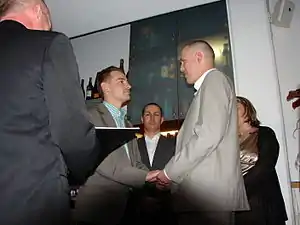
The 2016 New Zealand Attitudes and Values Study recorded that 2.6 percent identified as gay or lesbian, 1.8 percent bisexual, 0.6 percent bicurious, 0.5 percent pansexual and 0.3 percent asexual.[1]
History
Pre-colonial
Homosexuality and same-sex relationships have been documented in New Zealand for centuries. Same-sex relationships and activities appear to have been acceptable amongst pre-colonial Māori.[2] Some stories, for example that of Tutanekai and Tiki, centre on same-sex couples. A British missionary, Richard Davis, found homosexual relationships between men to be a familiar part of Māori life, and although homosexual relationships between women have not been well documented, they were certainly not condemned.[3] The Māori language word takatāpui had historically referred to devoted relationships between people of the same sex, but in modern terminology encompasses LGBT identity and sexuality.[4] The word whakawāhine (literally to become a woman) describes those who were assigned male at birth but act, dress and behave as female, while the term tangata ira tāne has the opposite meaning, that being a person assigned female at birth but behaves as male.[2]
Some of the earliest European settlers in New Zealand were Christian missionaries who arrived in the early nineteenth century and eventually converted most of the Māori population to Christianity. They brought with them the Christian doctrine that homosexuality was sinful. Despite this, one missionary, William Yate, was sent back to England in disgrace after being caught engaging in sex with young Māori men.[5]
Criminalisation and underground culture
When New Zealand became a British colony in 1840, British law was adopted in its entirety, making "buggery" illegal and a capital offence. In 1893, all kinds of sexual activity between men was criminalised, with penalties including imprisonment, hard labour, and flogging.[6] Sexual acts between women were never criminalised.[7]
Despite discriminatory laws, a small gay subculture developed. Pākehā settlers on the goldfields or in rural areas were mostly male, and some had sexual relationships with each other. However, as settlers began to move to cities the numbers of convictions for same-sex activities increased.[8]
A number of gay men were involved in New Zealand's literary subculture, including Frank Sargeson. However even in these circles, homosexuality was not always accepted.[9]
Lesbian subcultures are more difficult to detect, but in late 1971, the KG (Kamp Girls) club for lesbians was formed in Auckland.[10]
Activism and law reform
In 1962, the Dorian Society was founded in Wellington.[8] One year later, it established a legal subcommittee – the Wolfenden Association – out of which the Homosexual Law Reform Society emerged. Attempts to change the law included a petition presented to Parliament by the Homosexual Law Reform Society in 1968.[6]
Violence against gays and lesbians was often condoned. In 1964, Charles Aberhart was beaten to death in Christchurch's Hagley Park by a group of men who claimed he had propositioned them.[11] They were tried for murder but found not guilty. As in many countries, homosexuals were often committed to mental institutions and given 'treatment' for what was rendered a mental illness.[7]
In 1972, academic Ngahuia Te Awekotuku was denied a visitors permit to the United States on the grounds that she was a homosexual. Publicity around the incident was a catalyst in the formation of gay liberation groups in Wellington, Christchurch and Auckland.[12] The 1970s saw the growth of the modern feminist and gay movements in New Zealand. The Sisters for Homophile Equality (SHE), a lesbian feminist collective, formed in Wellington in 1973. In December of that year, SHE began to publish Circle, later renamed Lesbian Feminist Circle; the magazine continued to publish until 1986.[13]
After several attempts, the Homosexual Law Reform Act was passed in 1986, decriminalising sexual activity between men over the age of 16.[14] In 1993, discrimination on the grounds of sexual orientation was outlawed. In 2004 New Zealand instituted civil union (for both same-sex and opposite sex couples), and in 2013 same-sex marriage was legalised.[15]
New Zealand was unique in passing homosexual law reform in the midst of the AIDS crisis. The New Zealand AIDS Foundation was established in 1985.[15] Supporters of reform argued that removing the stigma from homosexuality would help prevent the spread and aid the treatment of disease. AIDS has primarily affected the gay male community in New Zealand (since records began in 1985, 53.7 percent of new HIV cases have been reported to be acquired by "male homosexual contact"),[16] and gay men are prominent in AIDS fundraising and in running organisations such as the AIDS Foundation.
LGBT Pride

New Zealand's first gay pride week was founded in the 1970s in the wake of the Stonewall riots in New York of 1969, the symbolic start of the modern Gay Rights Movement. In 1991, New Zealand's most prominent gay pride event, the Hero Parade, was founded in Auckland. This developed into a festival that became burdened by financial problems, leading to the last Hero Parade being held in 2001. However, the parade returned as the Auckland Pride Parade in 2012, then transitioned to become the Auckland Pride March in 2019. Starting in 1986, Wellington hosted an "Out in the Park" fair, which later evolved into the annual Wellington Pride Festival.[17] The festival ties in with the Pride Parade which started in 2017, following on from several pride parades held in the 1990s.[18]
Demographics
Various surveys have recorded statistics on sexual orientation. According to the General Social Survey (GSS) of 2018, 3.5 percent of New Zealand adults identified as LGBT, with 1.9 percent identifying as bisexual and 1.1 percent as gay or lesbian.[19] The 2016 New Zealand Attitudes and Values Study found that 94.2 percent of New Zealanders identified as straight or heterosexual, 2.6 percent as gay or lesbian, 1.8 percent bisexual, 0.6 percent bicurious, 0.5 percent pansexual and 0.3 percent asexual.[1]
Another source of sexual orientation statistics comes from the New Zealand Health Survey commissioned by the Ministry of Health. There has not been an official release of the demographics but an article using the Health Survey for years 2016 to 2017 reported that 2.4 percent of the sampled population reported being homosexual or bisexual.[20] However, there could be some under reporting given that 7.3 percent of the sample either did not know their sexual identity or refused to answer the question.[20]
Statistics New Zealand has collected some information on same-sex couples who share a residence, recorded in censuses since 1996. The 2013 census recorded 16,660 people living in a same-sex couple in New Zealand – 0.9 percent of all couples (3,672 were male couples and 4,656 were female couples). Most same-sex couples did not have children (6,852, compared with 1,476 who had children).[21] Statistics New Zealand proposed adding questions on sexual orientation and gender identity in the 2018 census; however, pre-census testing found the questions were poorly received by participants and the data collected was of sub-standard quality, so the proposal was dropped.[22]
Youth
A 2012 government survey of secondary school students (ages 13 to 18) recorded that 92 percent were exclusively attracted to the opposite sex, while 4 percent were attracted to the same sex or both sexes and 4 percent were not sure or were attracted to neither sex. Asked about gender identity, about 1 percent of students reported that they were transgender, while 3 percent were unsure.[23]
Prominent gay, lesbian and transgender New Zealanders
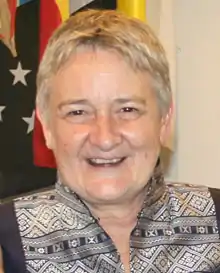
New Zealand has several LGBT people in parliament. Chris Carter (Labour, Minister of Conservation) became New Zealand's first openly gay MP when he outed himself shortly after being elected in 1993. Tim Barnett (Labour) was openly gay before being elected in 1996. Even earlier Marilyn Waring, a New Zealand National Party MP in the 1970s and 1980s, was also outed as a lesbian during her term and subsequently re-elected.[25] She refused to comment at the time but "came out" in 1985, one year after her political career had ended. Since 2005 several more openly LGBT MPs have been elected, including for both the major parties. There have also been other openly gay government ministers, such as Attorney General Chris Finlayson who was the National Party's first openly gay minister,[26] and Labour's Grant Robertson, the first openly gay Minister of Finance.[27]
New Zealand also elected the world's first out transgender MP. Georgina Beyer was elected to Parliament in the 1999 election for the seat of Wairarapa, and left Parliament on 14 February 2007.[28] Before entering parliament, Beyer was the world's first out transgender mayor, of the small town of Carterton.[29]
New Zealand is also a home for Eliana Rubashkyn, an internationally-known former LGBTI refugee, who became stateless several years in China after a severe case of discrimination due to her intersex variation,[30] and received subsequently a universal recognition of her gender by a U.N. declaration, making her case a first in the world.[31]
As in many other countries, there are numerous gays and lesbians involved in various branches of the arts. They include Whale Rider author Witi Ihimaera, dancers Michael Parmenter[32] and Douglas Wright, award-winning teen book author Paula Boock and former Chief Censor Judge Bill Hastings. The creator of the Rocky Horror Show Richard O'Brien also spent most of his childhood in Hamilton.
Openly gay athletes are relatively rare in New Zealand sports. Equestrian Olympic medal winner Blyth Tait,[33] Olympic speed skater Blake Skjellerup[34] and footballer Hannah Wilkinson are exceptions.[35]
Gay and lesbian life in New Zealand today
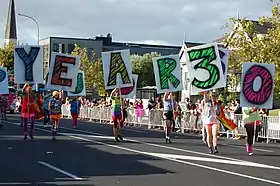
Today, New Zealanders are generally accepting of gays and lesbians, although some homophobia (such as the use of the word 'gay' as an insult[36]) is present.[37] Same-sex partners are accepted as the equivalent of heterosexual couples for immigration and most other purposes.[38]
The gay scene in New Zealand is reasonably small by international standards. However Auckland has multiple LGBT venues and festivals, as well as being voted the 15th gayest city in the world.[39] Outside Auckland, larger cities and some towns host one or two LGBT pubs, or clubs. Many smaller centres have LGBT organisations and social networks that cater to their community. In May 2015, PlanetRomeo, an LGBT social network, ranked New Zealand as the happiest country in Oceania (and the eleventh worldwide) for gay men.[40]
The internet is often used by gay men in New Zealand to meet others, especially in areas which lack specifically gay venues. Since at least 2005, the most popular LGBT site in New Zealand is the not-for-profit site gay.co.nz,[41] started as a community project by a New Zealand internet company.
A fortnightly lesbian event called 'Flirt' is held in Auckland, on the first and third Saturday of each month.[42] Elaborate Lesbian Ball[43] events are held annually in Auckland, Wellington and Christchurch.
There are a number of gay and lesbian festivals in New Zealand. Hamilton, Wellington, Tauranga, Christchurch and Dunedin host annual Pride Weeks, usually operated by the local UniQ, related youth-focussed organisations, or the New Zealand AIDS Foundation as a community-building initiative. The Out Takes film festival was a popular event in Auckland, Wellington and Christchurch, and while the organisation pulled the 2008 festival due to funding issues, it returned in 2009.[44]
Until 2008, the Hero Festival was held in Auckland each February, and included the Hero Parade, which attracted huge crowds, both gay and straight. Financial problems in 2001 led to the parade's demise, but the festival continued as a celebration of the city's LGBT citizens and comprised many events throughout February, including the popular Big Gay Out (in contrast to the music festival Big Day Out held in January), which is still held on the Sunday closest to Valentines Day each year.[45] Hero was wrapped up in March 2009[46] but the Auckland Pride Festival has been held annually since 2013, and is the largest LGBT Festival in New Zealand.[47]
Over the Christmas and New year period, a number of lesbian, gay, bisexual and transgender people attend summer camps at Vinegar Hill, New Zealand, in the Manawatu region.[48]
Gallery
 LGBTI flags flown at half-mast
LGBTI flags flown at half-mast Michael Fowler Centre
Michael Fowler Centre Michael Fowler Centre
Michael Fowler Centre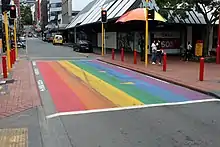 Wellington Rainbow Crossing
Wellington Rainbow Crossing Wellington International Airport
Wellington International Airport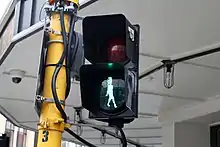 Carmen Rupe pedestrian crossing light
Carmen Rupe pedestrian crossing light
Gay and lesbian publications
- GayRepublic.co.nz – an LGBT community listing website, helping to promote community groups, businesses and upcoming events.
- GayNZ.com – Lesbian, Gay, Bisexual, and Transgender community news website for New Zealand.
- eikon – New Zealand[49]
- Guysers Gazette The e-magazine produced by Guysers Gaystay, Rotorua, New Zealand
- express – Auckland, New Zealand, originally 'Man to Man', 1991–present[50]
- Tamaki Makaurau Lesbian Newsletter – Auckland 2, Aotearoa, New Zealand,1991–?
- Lesbian Feminist Circle – Wellington, New Zealand, "For Lesbians only" collectively produced c1973-1976[51]
- Out!, 1976–2009[52]
- Pink Triangle, 1979–1990.
- Bitches, Witches, & Dykes – Auckland, New Zealand 1980–1981
- Lesbians in Print – Auckland, New Zealand, 1987
- Sapphic star Auckland, New Zealand c1989-1991
- UP magazine – Wellington, then nationwide, 2002–2006
See also
- Auckland Pride Festival
- Takatāpui
- Civil union in New Zealand
- GayNZ.com
- Hero Parade
- Homosexual Law Reform Act 1986
- HIV/AIDS in New Zealand
- LGBT rights in New Zealand
- Transgender rights in New Zealand
- Intersex rights in New Zealand
- Out Takes: A Reel Queer Film Festival
- Same-sex marriage in New Zealand
References
- Morton, Jamie (28 March 2016). "What Kiwis really think about ... race, sex, euthanasia, commuting and changing the flag". The New Zealand Herald. Retrieved 28 March 2016.
- Aspin, Clive. 'The Place of Takatāpui Identity within Māori Society: Reinterpreting Māori Sexuality within a Contemporary Context' A paper presented at Competing Diversities: Traditional Sexualities and Modern Western Sexual Identity Constructions Conference, Mexico City, 1 to 5 June 2005.
- Eldred-Grigg, Steven, Pleasures of the Flesh: Sex and Drugs in Colonial New Zealand 1840–1915, A.H & A.W Reed Ltd, Wellington. pp. 47
- Hutchins, Jessica; Aspin, Clive (2007). Sexuality and the Stories of Indigenous People. Huia. pp. 145, 7–13. ISBN 978-1-86969-277-3.
- Binney, Judith. "Yate, William 1802–1877". Dictionary of New Zealand Biography. Ministry for Culture and Heritage. Retrieved 4 April 2011.
- "Setting the scene – Homosexual law reform – NZHistory, New Zealand history online". Retrieved 22 August 2015.
- Laurie, Alison J (15 August 2018). "Lesbian lives". Te Ara – the Encyclopedia of New Zealand. Retrieved 11 October 2018.
- Brickell, Chris (11 May 2018). "Gay men's lives – History". Te Ara – the Encyclopedia of New Zealand. Retrieved 11 October 2018.
- King, Michael. "Sargeson, Frank 1903–1982". Dictionary of New Zealand Biography. Ministry for Culture and Heritage. Retrieved 4 April 2011.
- "Historical Events in the 1970s » PrideNZ.com". www.pridenz.com. Retrieved 11 October 2018.
- "Death in Hagley Park – Queer History New Zealand". www.gaynz.net.nz. Retrieved 11 October 2018.
- "Birth of the gay movement". Ministry for Culture and Heritage. 1 July 2014. Retrieved 30 January 2017.
- "A Chronology of Homosexuality in New Zealand – Part 2 – Queer History New Zealand". Retrieved 22 August 2015.
- "Reforming the law – Homosexual law reform – NZHistory, New Zealand history online". Retrieved 22 August 2015.
- Chris, Brickell (11 May 2018). "'Gay men's lives – Gay activism and law reform". Te Ara – the Encyclopedia of New Zealand. Retrieved 11 October 2018.
- "AIDS New Zealand newsletter, Issue 69" (PDF). Department of Preventative and Social Medicine, University of Otago and Ministry of Health (New Zealand). March 2012. Archived from the original (PDF) on 7 February 2014. Retrieved 25 July 2012.
- "Wellington Pride Festival – About". Wellington Pride Festival. Retrieved 14 January 2018.
- MacAndrew, Ruby (18 March 2017). "Thousands gather for Wellington's first Pride Parade in over 20 years". Stuff.co.nz. Retrieved 14 January 2018.
- "New sexual identity wellbeing data reflects diversity of New Zealanders". www.stats.govt.nz. Statistics New Zealand. 25 June 2019. Retrieved 22 July 2020.
- Surace, Anthony; Riordan, Benjamin C.; Winter, Taylor (26 May 2019). "Do New Zealand sexual minorities engage in more hazardous drinking than non‐sexual minorities?". Drug and Alcohol Review. 38 (5): 519–522. doi:10.1111/dar.12940. ISSN 0959-5236. PMID 31131504.
- "2013 Census QuickStats about families and households – tables". Statistics New Zealand. 4 November 2014. Archived from the original on 26 January 2015. Retrieved 22 February 2015.
- "Sex, gender, and sexual orientation". Statistics New Zealand. 25 January 2017.
- "People: The Social Report 2016 – Te pūrongo oranga tangata". socialreport.msd.govt.nz. Retrieved 1 February 2019.
- Laurie, Alison J. "Lesbian lives - Contemporary lesbian life". Te Ara: The Encyclopedia of New Zealand. Retrieved 21 July 2020.
- Macdonald, Nikki (17 May 2019). "Marilyn Waring: A woman's view of parliament from 1975 to 1984". Stuff. Retrieved 21 July 2020.
- "John Key appoints Nats' first openly gay minister". The New Zealand Herald. 17 November 2008. Retrieved 21 July 2020.
- Peters, James (1 August 2017). "Our gay man who could be the next Minister of Finance / by James Peters, Richard Todd, Levi Joule". Express (Auckland, N.Z.). Retrieved 22 July 2020.
- "GayNZ.com Beyer ends "the best time of my life"". Archived from the original on 24 September 2015. Retrieved 22 August 2015.
- Mitchell, Mark. "Carmen and Georgina Beyer". Te Ara: The Encyclopedia of New Zealand.
- "Raped and beaten for her gender identity, refugee's story of survival". Newshub. 14 April 2018. Retrieved 14 April 2018.
- Human Rights Campaign 2014. "Hong Kong recognized Trans woman without Sex reassignment Surgery".
- Vox, Dylan. "Equestrians Carry the Torch for Gay Olympians". Gaysports.com. Archived from the original on 28 September 2007. Retrieved 22 December 2008.
- Roberts, Adam (6 April 2011). "Olympic skater talks about bullying of gay students". The Nelson Mail. Retrieved 14 October 2011.
- https://outforthewin.com/en/hannah-24/
- Russell, Anne (9 November 2012). "Gay Red Stop: John Key and homophobic language | Scoop News". scoop.co.nz. Retrieved 22 July 2020.
- Suckling, Lee (17 November 2015). "Gay marriage is legal, but is it accepted?". The New Zealand Herald. Retrieved 22 July 2020.
- "Do we have to be married to qualify under the partnership instructions?". www.immigration.govt.nz. Immigration New Zealand. Retrieved 23 July 2020.
- "GayNZ.com Auckland ranked 15th gayest city in world". Archived from the original on 26 September 2013. Retrieved 22 August 2015.
- The Gay Happiness Index. The very first worldwide country ranking, based on the input of 115,000 gay men Planet Romeo
- http://rankr.projectxtech.com/site/show_tag/gay%5B%5D
- Flirt – Women's Club Night Archived 14 October 2008 at the Wayback Machine
- "Lesbian ball – Dancing". Te Ara: The Encyclopedia of New Zealand. Retrieved 22 July 2020.
- "GayNZ.com Out Takes 2009 film schedule revealed". Archived from the original on 24 September 2015. Retrieved 22 August 2015.
- "Hero – Gay & Lesbian News". Retrieved 22 August 2015.
- "GayNZ.com Hero to be wound up and remembered". Archived from the original on 24 September 2015. Retrieved 22 August 2015.
- "Gay Auckland Guide: The Essential Guide To Gay Travel In Auckland New Zealand 2018". Queer in the World. 3 May 2018.
- Wylie, Liz (30 December 2017). "Gay community celebrate forty years of camping at Vinegar Hill". The New Zealand Herald. Retrieved 22 July 2020.
- "Online magazine for New Zealand and Australian gay communities". Eikon. Retrieved 22 August 2015.
- http://www.expresstoday.co.nz
- "CAP to CUT – Serials List – Lesbian & Gay Archives of New Zealand". Retrieved 22 August 2015.
- "GayNZ.com NZ's longest-running gay magazine ends". Archived from the original on 24 September 2015. Retrieved 22 August 2015.
Further reading
- Brickell, Chris (2008). Mates & lovers: a history of gay New Zealand. Auckland: Godwit. ISBN 978-1-86962-134-6.
- Alice, Lynne; Star, Lynne, eds. (2004). Queer in Aotearoa New Zealand. Dunmore Press. ISBN 978-0-86469-4539.
- Laurie, Guy (2002). Worlds in Collision: The Gay Debate in New Zealand, 1960–1986. Wellington: Victoria University Press. ISBN 978-0-86473-4389.
- Laurie, Alison J.; Evans, Linda (2005). Outlines: lesbian and gay histories of Aotearoa. Wellington: Lesbian & Gay Archives of New Zealand. ISBN 978-0-47310-5556.
External links
| Wikimedia Commons has media related to LGBT in New Zealand. |
- A Chronology of Homosexuality in New Zealand
- A History of New Zealand Homosexual Law Reform
- New Zealand AIDS Foundation
- Auckland Pride Festival
- Out Takes Reel Queer Film Festival
- Rainbow Wellington LGBT social, business and political organisation
- Streaming audio and transcribed interviews on historic and current LGBTI issues in New Zealand